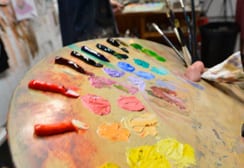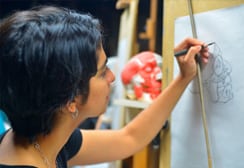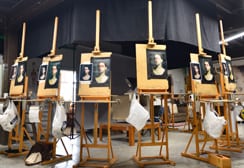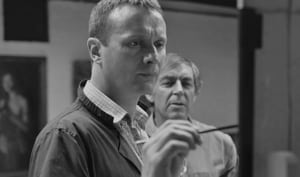
The drawing program is dedicated to improving our drawing skills. This may seem like a long time but the benefits are worth it. Drawing can be overlooked by many artists wanting to jump straight into painting but no amount of paint will compensate for bad draughtsmanship.
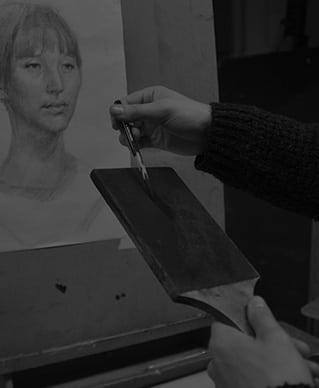
Cost
SOLD OUT
Timetable
Tuesdays | 9.30 – 4.30
27th Sep – 1st Nov | half term| 15th Nov – 20th Dec 2016.
Term 1 Principles of Drawing
The principles taught in the first term are the foundation of traditional art techniques.
First we need to learn how to observe and describe what we see. The exercises in each lesson are specifically designed to improve your observational skills. At the end of the term we will be putting it all together while learning the steps of a fully rendered portrait.
The exercises below have been developed to train your visual muscles. Each exercise builds on the last creating a solid foundation for future study.
Daily Schedule
Morning Session
Afternoon Session
Lesson
Each lesson may last between a morning to two weeks.
Topics Covered
Plotting
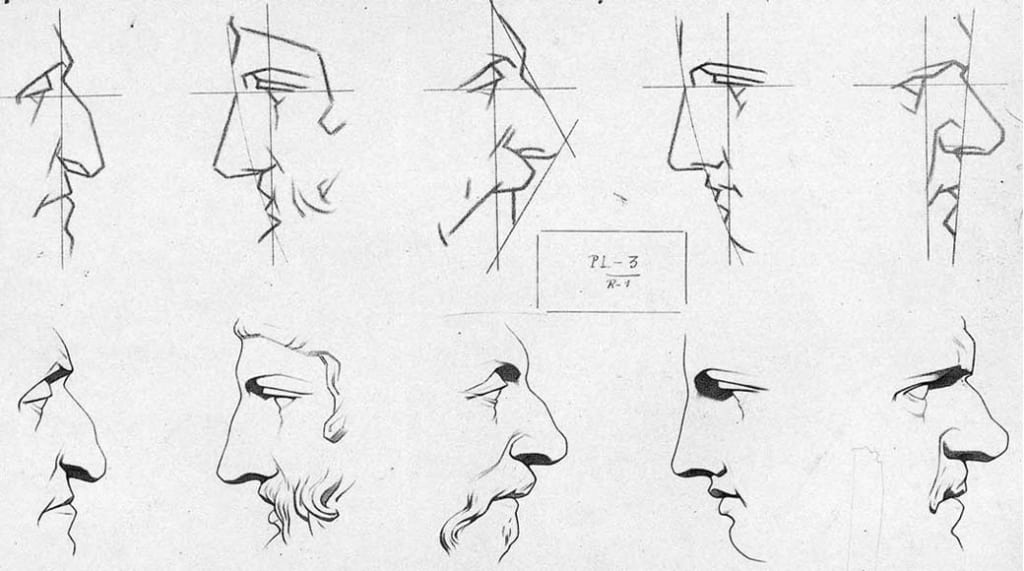
Lesson
Lesson = The aim of the lesson is to Imagine the face as a landscape and learn how to plot the features that create it.
Exercise = Plotting the features. Think of it as a dot to dot drawing. Plotting the points and then connecting them with a straight line. Straight lines give architectural strength and eradicate unnecessary details.
Model = Charles BargueMaster Drawings.
Outcome
Students will learn to:
- simplify complex forms into approximate straight lines.
- edit unnecessary information.
- improve decision making process.
Positive and Negative Space
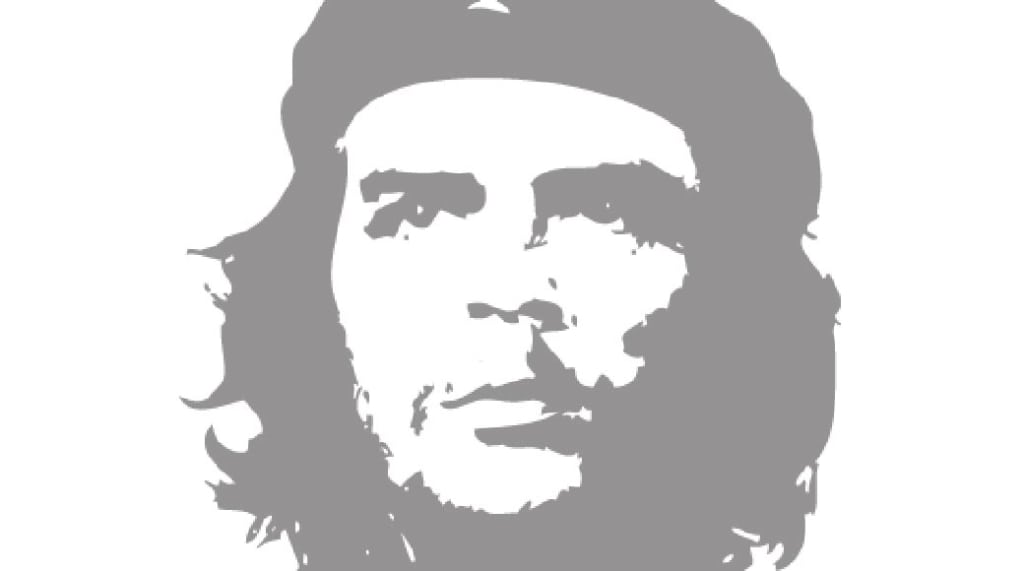
Lesson
Lesson = The aim is to place equal importance on Positive and Negative shapes. Positive and negative shapes are interdependent like the pieces of a jigsaw puzzle. For example when drawing the eye it’s tempting to just look at the eye itself without concidering the space around it.
Exercise = Group of exersizes loosening the perception of positive and negative space, seeing it as a whole.
Model = Arranging groups of objects and drawing only the negative space.
Homework = Draw the negative space between the leaves of the plant.
Outcome
Students will learn, the interdependence of negative and positive space.
Mass Drawing
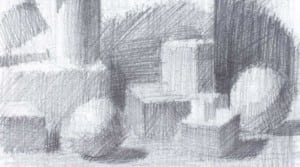
Lesson
Lesson = There are no outlines in nature, what defines a shape is the contrast between one tone or colour against another.
Exercise = Draw a group of geometric objects without using the tonal differences to define their shape.
Model = Use a group of simple geometric objects to work from.
Homework = Choose a composition in your home and repeat the exercise.
Outcome
Students will learn how to describe an object without using an outline.
Perspective
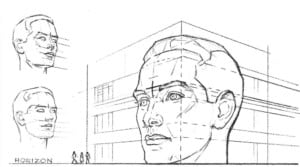
Lesson
Lesson = Learning the principles of perspective and how it relates to the head in space.
Exercises = Draw imaginary boxes in 1,2 and 3 point perspective. Using a photo reference exaggerate the perspective of a persons face.Model = Arrangement of boxes to be drawn applying the knowledge from previous exercises.
Homework = Repeat the exercise using a photo reference
Outcome
Students will learn,
- Understand the laws of perspective.
- Learn the difference between 1,2,3 point perspective.
- Draw a head in perspective.
Aerial Perspective
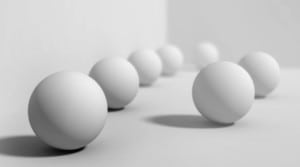
Lesson
Lesson = The theory of atmospherical perspective and how it can be applied to portraiture.
Exercises = Shading exercise observing the atmospherical effects of nature. Line weight exercises using strong sharp lines around the focal point of the eye gradually becoming softer as they radiate out towards the outline of the head.
Model = Using line weight to articulate a line drawing of the head.
Homework = Using a photo reference, repeat the exercise.
Outcome
Students will learn:
- The principles of atmospherical perspective.
- The use line weight to describe atmospherical perspective.
Anatomy of Light
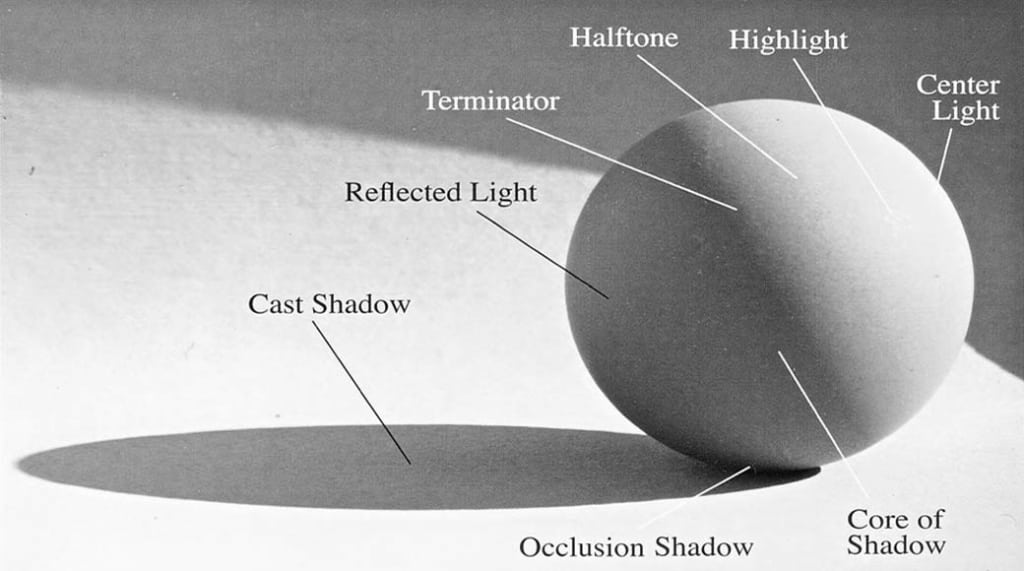
Lesson
Lesson = Once we have learned how to draw a believable looking head then its time to start rendering. Understanding the principles of light and shade are key to a well rendered portrait.
Exercises = Copy and label anatomy of light diagram.
Model = Render a sphere observing the principles taught in the lesson.
Homework = Draw an egg and label the anatomy of light and shade.
Outcome
Students will learn:
- anatomy terminology.
- principles of light and shade.
- basic shading techniques.
Edges
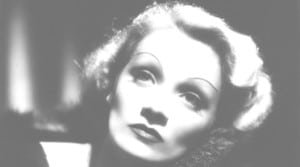
Lesson
Lesson = The use of edges to describe the volume of forms. How to observe the speed and variety of edges around the face.
Exercise = Line weight mapping exercise using soft and sharp lines to describe variation edges around the face.
Model = Apply what we have learned with a strongly lit model.
Homework = Repeat the rendering steps using a master drawing.
Outcome
Students will learn
The difference between soft and sharp edges, speed of an edge fast and slow.
How to compare edges.
Rendering
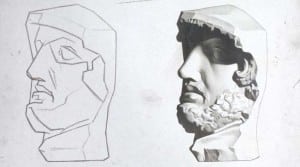
Lesson
Lesson = Learn the steps of rendering. We begin studying master drawings before tackling the live model. The Master drawings are simplified drawings of plaster casts taken from classical sculptures which help the student understand the basics of describing light and shade as it wraps around the features.
Exercise = Run through the steps of rendering a portrait using a master drawing.
Model = Repeat the exercise.
Homework = Either finish or repeat the exercise.
Outcome
Students will learn the basic steps of rendering. This process needs to be repeated until they become second nature.
Rendered Portrait
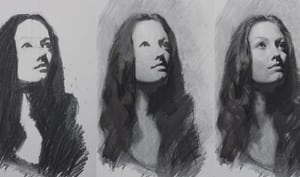
Lesson
Lesson = Now it’s time to put it all together and begin honing our skills for the remainder of the term.
Exercise = Practice all the steps we have used so far working from life for the remainder of the term.
Model = Students work from a portrait model.
Homework = Practice rendering steps with a sitter, photo or self portrait.
Outcome
Students will learn:
- how to hone their skills.
- how to render a portrait.
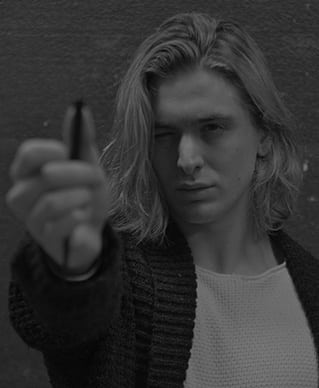
Cost
£883 per term.
Timetable
Tuesdays | 9.30 – 4.30
3rd Jan – 7th Feb | half term | 21st Feb – 29th March 2017.
Term 2 Rendering
In the first term we will be focusing on the structure of the head. We need to create a basic structure before adding the features. Think of the skull itself as the structure and the rest as merely trimmings.
The exercises below are designed to improve your observation skills and decision making process when tackling a portrait.
Daily Schedule
Morning Session
Afternoon Session
Lesson
Each lesson may last between a morning to two weeks.
Topics Covered
Proportion
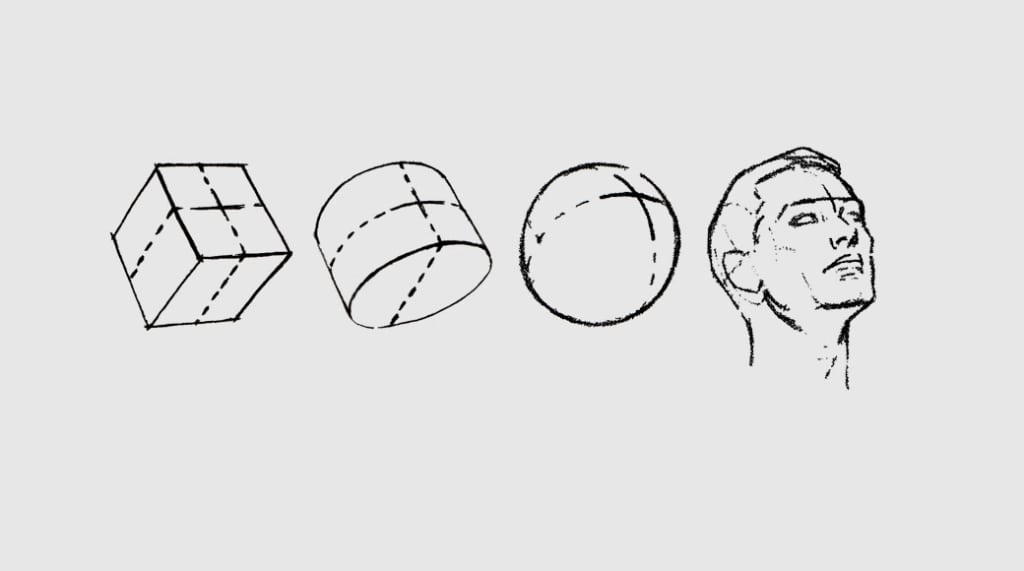
Lesson
Lesson = The aim of this lesson is to memorise the Proportions and geometry of the head. Learning foreshortening, perspective and how to draw the head from any elevation.
Exercise = We will be creating a simplified 3D model to understand the proportions and geometry of the head. how to draw the structure from any angle.Using a square, cylinder and sphere as a 3 dimensional model.
- Draw a square in 3 point perspective from any angle.
- Draw an eclipse from any angle.
- Draw a cylinder in 3 point perspective from any angle.
- Make a proportional armature of the head made from polystyrene.
Model = 3D Model.
Homework = practice drawing the basic structure of the head from multiple angles.
Outcome
Students will learn,
- foreshortening of the head looking up or down.
- basic perspective and geometry of the head.
- proportions of the head.
Skull
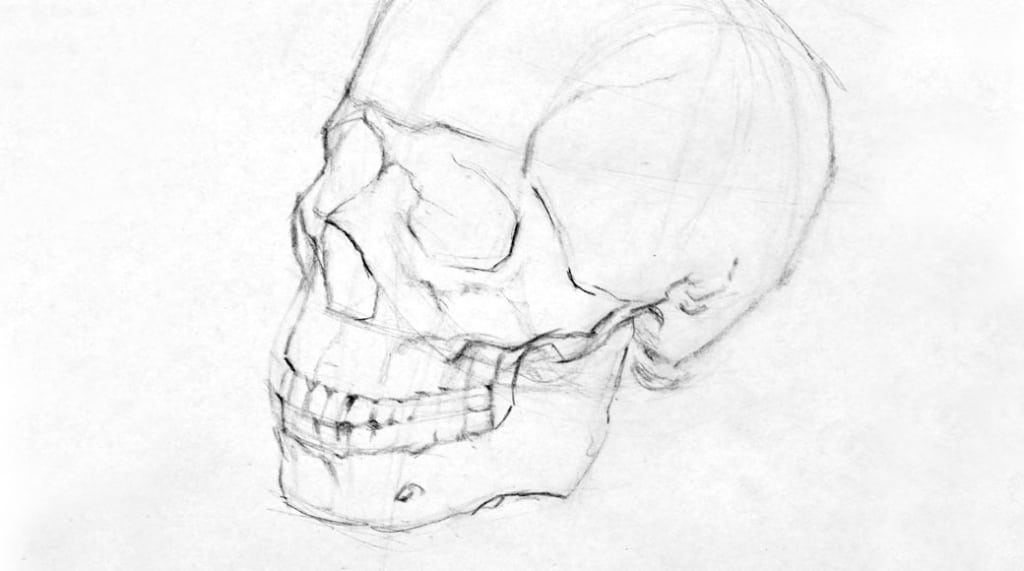
Lesson
Lesson = Learn the anatomy of the skull and how the bony protrusions affect the features of the face.
Exercise = Draw the skull from a front, side and three quarter view. Using a photo reference of a model trace the outline of the skull observing the skulls protrusions.
Model = Repeat the exercise with a portrait model.
Homework = Draw Skull thumbnails from a variety of elevations.
Outcome
Students will learn:
- the anatomy of the skull.
- the bony protrusions and how it affects the surface.
- how the Loomis armature and proportions work with the skull.
- memorise the skull from a variety of elevations.
Anatomy
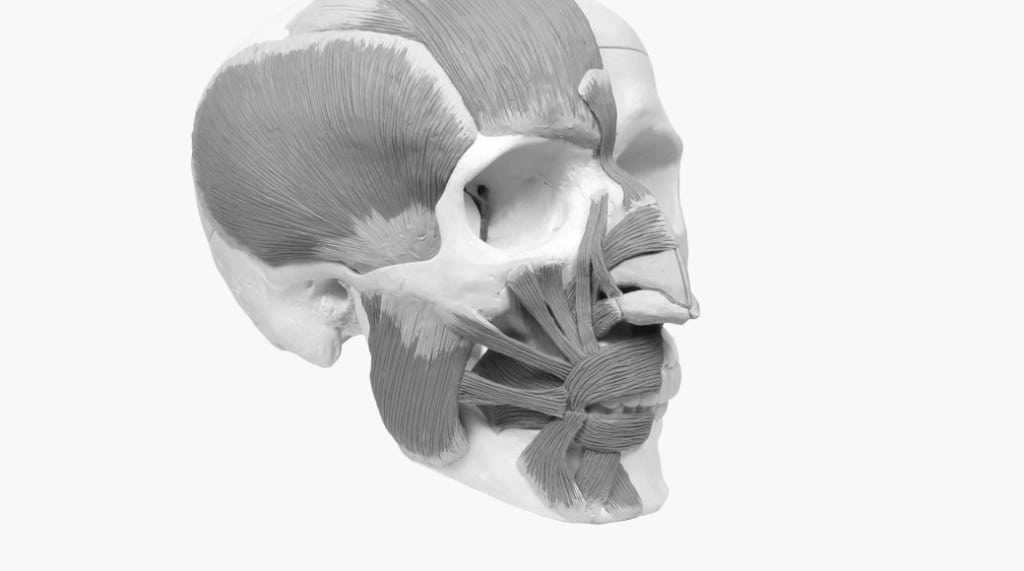
Lesson
Lesson = We will be learning about muscle anatomy and how it affects the surface of the face.
Exercise = Based on the “Ecorche” method meaning flayed figure. We will be using the skull as a base to sculpt the muscles of the face using plasticine.
- Draw muscle anatomy from front,side and three-quarter view.
- Trace the outline of the muscular anatomy on to a photo reference of a face from various elevations.
Model = Repeat the exercise using a live model.
Homework = repeat this exercise using a photo from different elevations.
Outcome
Students will learn how, the anatomy of the muscles affects the surface of the face.
Rhythm
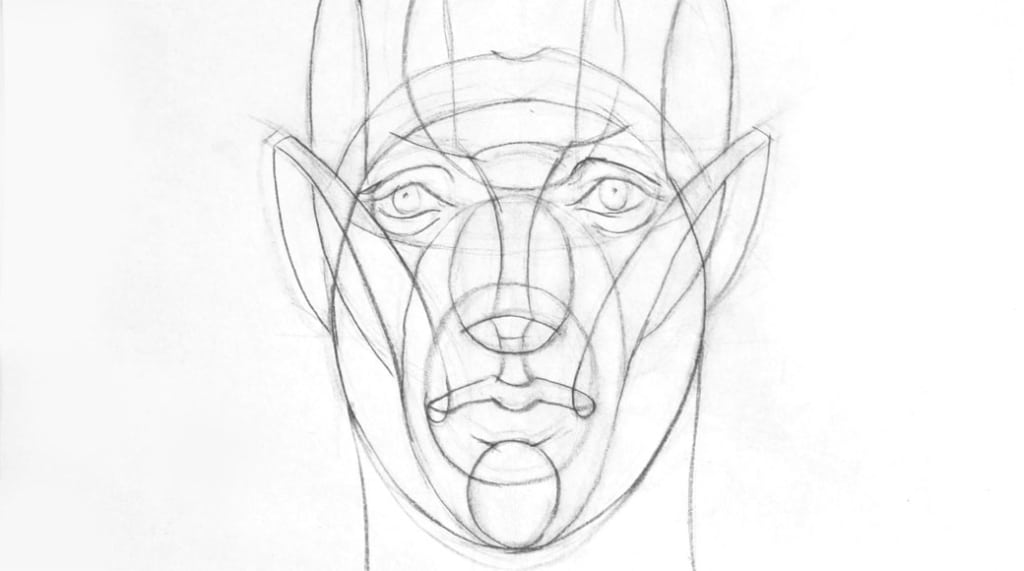
Lesson
Lesson = Observe the rhythmic lines of the face. This is probably one of the most beneficial things taught on this program. It’s a useful tool for locating the major and minor landmarks of the face.
Exercises= Copy rhythm diagram, front, side and three-quarter view. Trace the diagram over a photographic references of the model.
Model = Apply what we have learned to the model using the Rhythm lines as a basic structure for the face.
Homework = Practice using the construct with a sitter or photo reference.
Students will learn, simplification, idealisation, hand dexterity.
Planes of the head
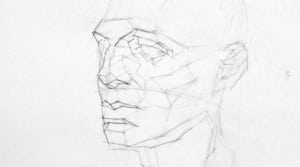
Lesson
Lesson = Observe the rhythmic lines of the face. This is probably one of the most beneficial things taught on this program. It’s a useful tool for locating the major and minor landmarks of the face.
Exercises= Copy rhythm diagram, front, side and three-quarter view. Trace the diagram over a photographic references of the model.
Model = Apply what we have learned to the model using the Rhythm lines as a basic structure for the face.
Homework = Practice using the construct with a sitter or photo reference.
Students will learn, simplification, idealisation, hand dexterity.
Features
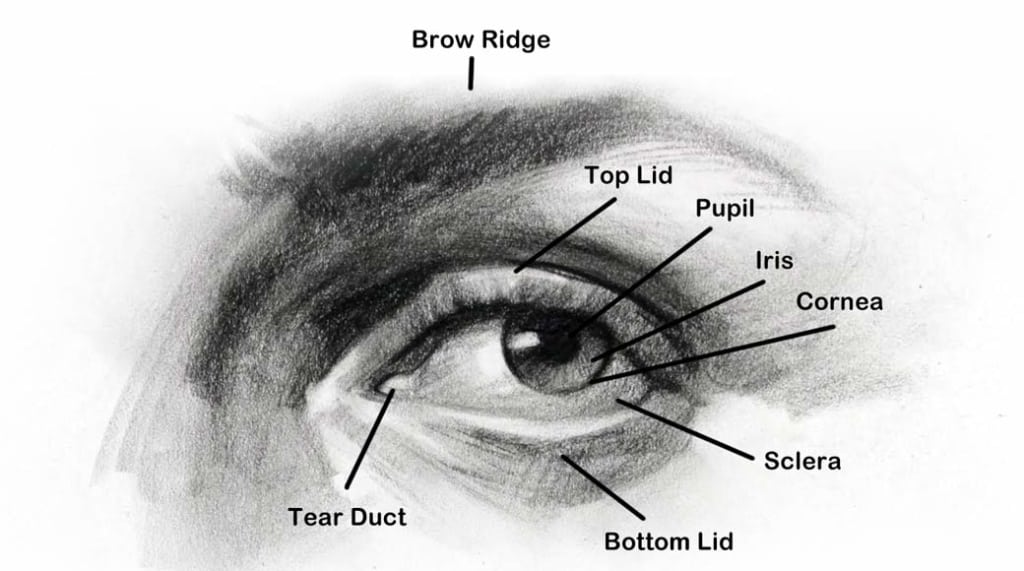
Lesson
Lesson = In the first term we looked at the overall structure. Now its time to investigate the smaller features, looking at the eyes, nose, mouth and ears.
Exercises = We will be using a variety of different resources such as Loomis, Bargue and Bridgemann to explore the characteristics of the face.
Model = Apply what we have learned to the model with individual studies.
Homework = Practice using a mirror to investigate the features of your face.
Outcome
Students will learn:
- surface anatomy.
- characteristics of each feature.
Short Studies
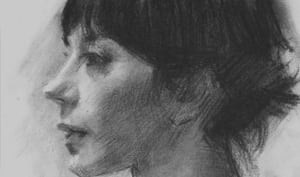
Lesson
Lesson = Practice makes perfect, the more we repeat the process the quicker we will become.
Now we start to work within a time limit. Its quite simple the longer we have the longer we take. Setting ourself a time limit cuts through procrastination, second guessing and unnecessary detail.
The times will become shorter as we go along working on 1hour, 30min and 10 min sketches.
Exercise = Short studies varying in time. Between each session students are encouraged to weed out any problems that may be slowing them down.
Model = Practice portrait working from a portrait model.
Homework = Practice short studies with s sitter, photo or self portrait.
Outcome
Students will learn:
- what little is needed to create a convincing portrait.
- self assessment.
- decisiveness.
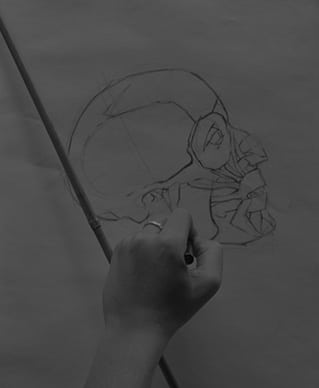
Cost
£883 per term.
Timetable
Tuesdays | 9.30 – 4.30
11th April – 16th May | half term | 30th May – 4th July 2017.
Term 3 Interpretation
In this term we will be focusing on developing on style. Looking towards some of the masters for inspiration. By imitating renowned portrait artists such as Sergeant we can learn how to interpret the visual world and the poetical language they used to describe it and use their influence to enrich your own individual expression.
Speed and efficiency
The exercises below have been created to develop your interpretation and style. We will also be working on improving speed, efficiency and bravado.
Daily Schedule
Morning Session
Afternoon Session
Module
Each module may last between a morning to two weeks.
Topics Covered
John Singer Sargent
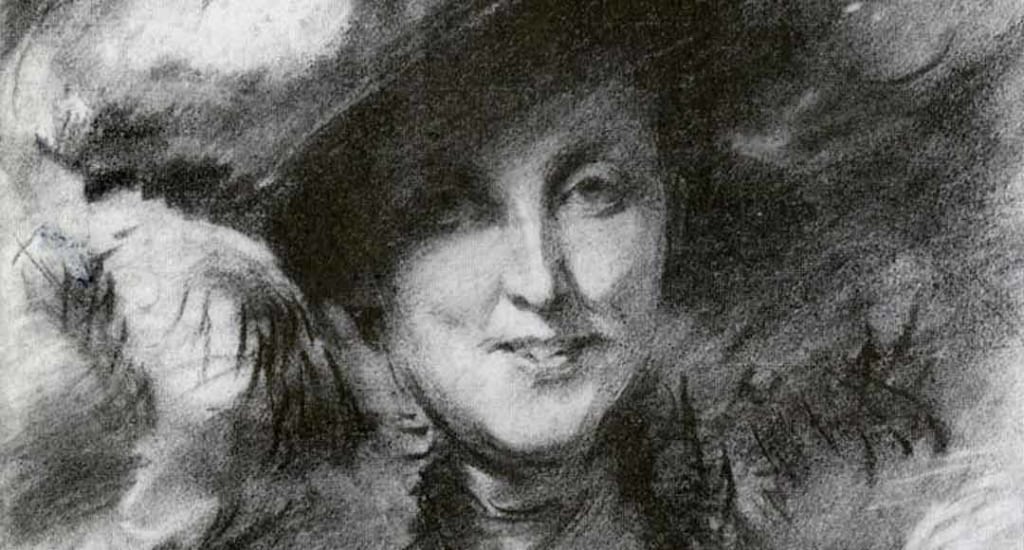
Lesson
Lesson = Learning how Sargent used strong lighting effects to illuminate the subject and the bold loose marks he used to describe the character of the person.
Exercise = Study a Sargent charcoal drawing.
Model = Set up a model with strong lighting effect and draw the portrait in a similar style.
Homework = Study John Singer Sargent Charcoal. Draw a portrait in similar style either sitter or photo reference.
Outcome
Students will learn to draw with a lose bold style.
Nicolai Fechin
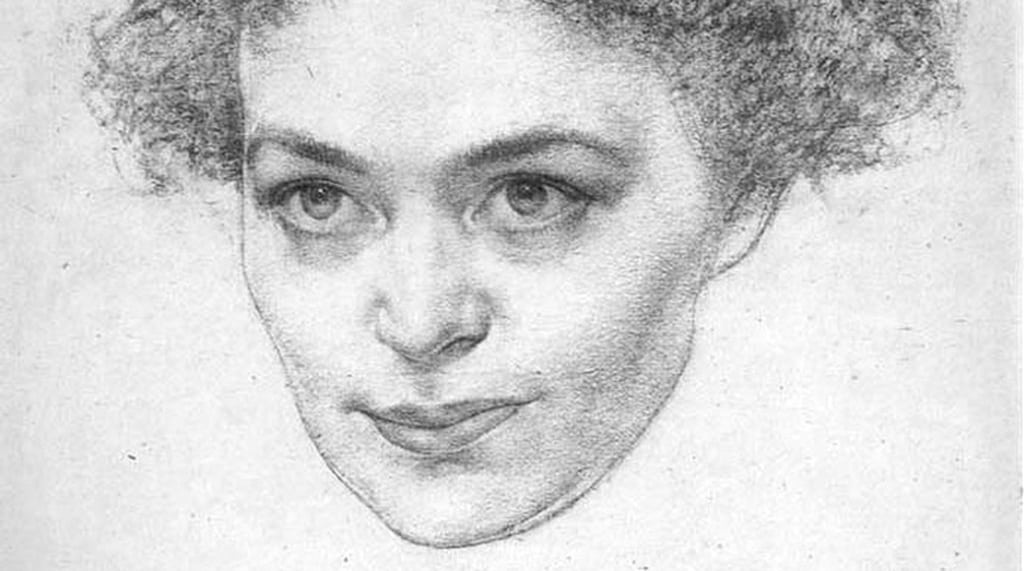
Lesson
Lesson = Nicholia Fechin uses a soft lit model to create a subtle look.This effect works well with women emphasising the smooth rounded surface.
Exercise = Study a portrait drawing by Nicholia Fechin.
Model = Using soft lighting, practice the technique on the model.
Homework =Study Nicholia Fechin charcoal. Draw a portrait in similar style either sitter or photo reference.
Outcome
Students will learn how to, describe soft subtle forms. A useful technique when dealing somebody young and the female form.
Exhibition Piece
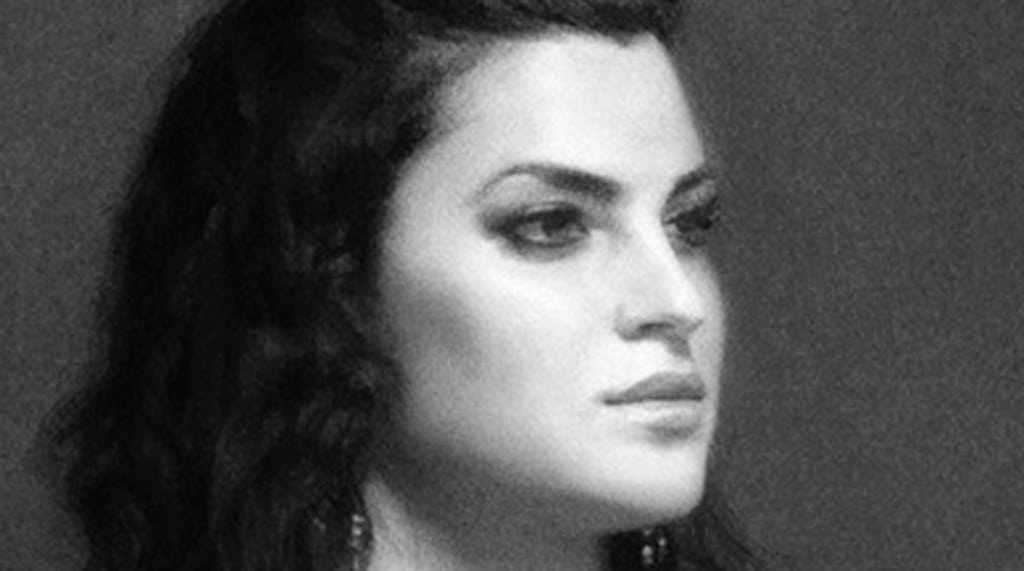
Lesson
Lesson = Students will have extra time to work on a piece for the end of the year exhibition. They will also be able to show some of their best work throughout the year. Friends and family are welcome to see how far the students have advanced from the start of the program.
Exercise = Prolonged study, bringing all the elements together taught over the year.
Model= Portrait Model.
Practice = Repeat the process in own time.
Outcome
Students will learn how to deal with pressure and how it can effect your flow.


